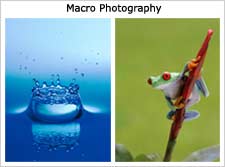Macro photography, also known as macrophotography, refers to taking pictures of small things at close range. Although macro photography traditionally referred to taking pictures with a sensor that is larger than the subject, it currently includes taking pictures in which the image appears at least as large as it does in reality. The advent of digital cameras has made macro photography more accessible to the general photographer. Yet, professional macro photography with traditional cameras requires a keen awareness of lighting, focus and lens requirements.Traditionally, macro photography is defined as any photo in which the subject has a 1:1 ratio with the photo negative. This means that the image of the subject on the negative is exactly the same size as the real life subject. So, no magnification is used. With the development of digital cameras, the old definition of macro photography has begun to change. Today, zoom lenses and magnification are often used for macro photography. Macro photography requires a number of different accessories, including a macro lens, an extension tube to attach a lens to the camera and a reversing ring (an attachment allowing the photographer to attach the lens backwards). Other tools, such as a close-up lens or a telephoto extender, may also enhance macro photos.The concept of macro photography is becoming more inclusive: if a tool or technique improves the final picture, use it!Macro Photography Subjects
With the development of digital cameras, the old definition of macro photography has begun to change. Today, zoom lenses and magnification are often used for macro photography. Macro photography requires a number of different accessories, including a macro lens, an extension tube to attach a lens to the camera and a reversing ring (an attachment allowing the photographer to attach the lens backwards). Other tools, such as a close-up lens or a telephoto extender, may also enhance macro photos.The concept of macro photography is becoming more inclusive: if a tool or technique improves the final picture, use it!Macro Photography Subjects
Any small object can be a subject for macro photography. A good macro photo reveals details and textures in the object that can’t be observed with normal photography or by an undiscerning eye. By definition, macro photography subjects are endless! Because macro photography enhances the details of its subject, nature serves as an excellent subject for them. For photographers just beginning to experiment with macrophotography, here are some possible subject ideas:
- baby feet or fingers
- butterfly wings
- clockwork gears
- clothes with unusual textures
- feathers
- fern fronds
- flower petals
- insects
- sea shells
- spider webs.
Images for macro photography can be limited only by the photographer’s imagination. While nature provides the most obvious subjects for macrophotography, common items around the house are also possible subjects.
Traditional Macrophotography
Macro photography with a traditional camera requires the use of an SLR, or single-lens reflex camera. An SLR camera shows the image in the lens through the viewfinder in its exact dimensions. When working with macrophotography even a slight deviation between what is seen in the viewfinder and what the lens captures can ruin a photo.The SLR camera must be fitted with a lens that supports macro photography. There are two types of macrophotography lens: a “macro zoom lens” and a true macro lens.A macro zoom lens is, essentially, a magnification lens that attaches to the camera. This lens produces pictures that are of inferior quality to those rendered by a true macro lens. However, the macro zoom lens is considerably less expensive and is a good choice for the beginning macro photographer.
Digital Macrophotography
Many digital cameras come with macro photography settings, greatly increasing the number of amateur photographers interested in macro photography.Once the camera is set to macrophotography, the photographer only has to zoom in on the subject and take the picture. The LCD screen is one of the key digital camera tools used in macrophotography. Using the LCD screen, the photographer can get closer to his or her subject and can quickly check the photo to see if a retake is needed.However, the LCD screen consumes battery power, so bring extra batteries if you’re planning to take many of these shots.Macro Photography and Camera Control
Macro photography requires a very steady camera hand: the slightest camera movement can result in a blurry picture, especially if the camera is zoomed in for the close-up. While a tripod improves Macro photography pictures, the location of some nature subjects means that tripod use isn’t always possible.
Wind, even a small breeze, can move a macrophotography subject enough to cause blur on the picture. To avoid this, try to prevent the wind from reaching the subject. Taking the photo at a very high shutter speed helps catch a clear image when wind is a factor.Macrophotography and Light
Lighting can be a problem for macro photography. Although flashes may provide needed light in some cases, they can also provide too much brightness when the subject is close to the camera. To get around this, place external flashes further away from the subject.Another possibility for lighting macro photography is a light reflector. Light reflectors are available in camera stores and come in white and gold finishes.Whether done with a manual or digital camera, macro photography pictures can reflect the beauty of an insect, small coin, flower, or any other small and overlooked item.

Wilkipedia?
Yeah... I needed a story for the group to get accepted
all that and not one mention of bellows ? == like extension tubes only better as more adjustable for fine control.